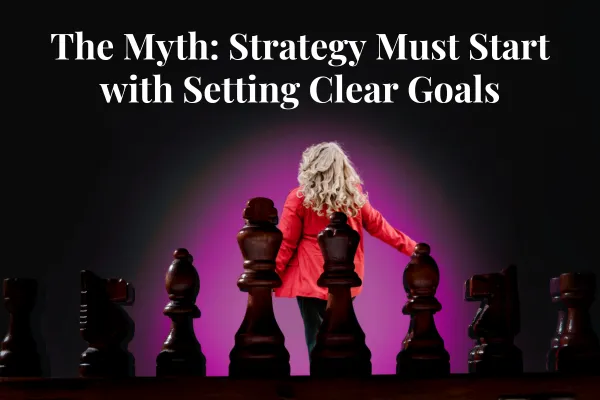

'INSIDE THE LAB'
BUILD A PROFITABLE ONLINE BUSINESS
The blog with simple strategies to grow and monetise
Join other Strategy Success Labsters 'INSIDE THE LAB'; a free newsletter for creative small business to grow & monetise your internet business.
I'm a GDPR obsessed, so everything in The Lab is tickety boo!
'INSIDE THE LAB'
BUILD A PROFITABLE ONLINE BUSINESS
The blog with simple strategies to grow and monetise.
Join other Strategy Success Labsters 'INSIDE THE LAB'; a free newsletter for creative small business to grow & monetise your internet business.
I'm a GDPR obsessed, so everything in The Lab is tickety boo!

The Myth: Strategy Must Start with Setting Clear Goals
Have you ever heard the saying that all great journeys begin with a clear destination in mind? In business strategy, there’s a common belief that everything must kick off by setting clear, specific goals. This concept has deep roots in traditional business teachings, influenced heavily by theories like Chandler’s definition of strategy, (Chandler, 1962, p. 13), which suggests that the success of an enterprise hinges on the clarity of its long-term goals. This approach seems straightforward and reassuring, especially in a world that loves clear directions.
Why This Myth Persists
This goal-first strategy is particularly appealing because it promises a simple blueprint for success. It's been echoed through the ages by influential business thinkers, including Simon Sinek’s popular idea of finding your 'why', promoting a vision-driven approach to motivate and guide organizations. It's a tempting route because it gives a sense of security and a clear checklist of what to aim for.
Why It's Wrong for Everyone, Especially Business Owners with ADHD
However, insisting on a goal-first approach can be misleading and restrictive. It presumes that the most important step in strategy is to have a clearly defined endpoint right from the start. This overlooks the dynamic nature of business and human creativity; areas where business owners with ADHD can really shine due to their ability to think flexibly and outside the box. Here’s why sticking rigidly to initial goals might not be the best approach:
Goals Are Limited by Our Perception of Possibility: Our aspirations are often constrained by what we currently believe is achievable. For business owners with ADHD, who might already feel overwhelmed by the need to conform to conventional expectations, this can be limiting. The creative potential to see beyond the 'faster horses' can be stifled by overly rigid goal setting.
Action Inspires Goals, Not the Other Way Around: In dynamic business environments, goals often emerge and evolve through the process of action—something that can be very natural for ADHD brains that thrive in responsive and adaptive settings. This spontaneity can lead to innovations that predefined goals might never have allowed.
Strategy Is an Ongoing Process: Strategy isn’t a set-and-forget event; it's continuous and evolves without a defined start or stop point. For those with ADHD, the idea of continuous adaptation and change can be more appealing and less daunting than rigid structures.
Goals Can Divert Attention from Present Needs: Overemphasis on future goals can distract from addressing urgent current challenges that might be more pressing and relevant. This is particularly pertinent for ADHD business owners who benefit from focusing on present realities that impact their business directly.
Relevance of Goals Can Be Overrated: The focus on achieving specific goals might overshadow more important aspects like the value created for customers and the community. Shifting focus from self-centric goals to community-centric value can be more fulfilling and impactful for business owners with ADHD, who often look to make a meaningful difference.
What to Do Instead
Rather than locking into a set of initial goals, encourage a culture where strategy evolves naturally. This approach is not only more adaptable but also allows business owners with ADHD to leverage their strengths in creativity and innovation.
How to Get Started
Begin by fostering an environment that values flexibility and responsiveness, attributes that are naturally aligned with the ADHD mind’s way of operating:
Encourage Open Communication: Create an atmosphere where ideas can flow freely. This is crucial for ADHD brains that may jump from one idea to another—these transitions can foster unexpected breakthroughs.
Adopt Agile Methodologies: Utilize frameworks that accommodate continual adjustment and quick responses, perfect for the fast-paced thinking style of someone with ADHD.
Focus on Learning and Adapting: Continuous learning supports the ADHD tendency to seek new and exciting information, keeping engagement high.
Actionable Tips
Tip #1: Regularly revisit your strategic approach. Keep your strategy dynamic rather than static—this plays to the strengths of the ADHD mind, which thrives on novelty and change.
Tip #2: Embrace diverse perspectives. Engaging different viewpoints can help in recognizing opportunities that a single-minded focus on goals might miss—particularly beneficial for ADHD brains that can think in unique ways.
Tip #3: Stay informed and adaptable. Keep abreast of industry trends and shifts, allowing for a strategy that adapts proactively—an approach that suits the naturally curious and flexible ADHD mind.
Remember: Believing the Goal-Setting Myth Is Limiting
Believing that strategy must start with clear goals limits flexibility and misses out on opportunities for innovation—something that can be particularly constraining for business owners with ADHD. Embrace a strategy that adapts and evolves; it’s a much better fit for your dynamic way of working.
There’s a Better Way
By moving away from rigid goal-setting to a more fluid and responsive strategic approach, you not only cater to the strengths of the ADHD brain but also build a business that’s resilient, adaptive, and more aligned with real-world dynamics. Let your strategy evolve with your actions, and watch how your business flourishes in ways that rigid planning could never predict.
Chandler, A.D.Jr. (1962) Strategy and Structure. The MIT Press.
Jeroen Kraaijenbrink. (2019) Strategy Myth #3: Strategy Starts With Goals. Forbes. https://www.forbes.com/sites/jeroenkraaijenbrink/2019/04/05/strategy-myth-3-strategy-starts-with-goals/
